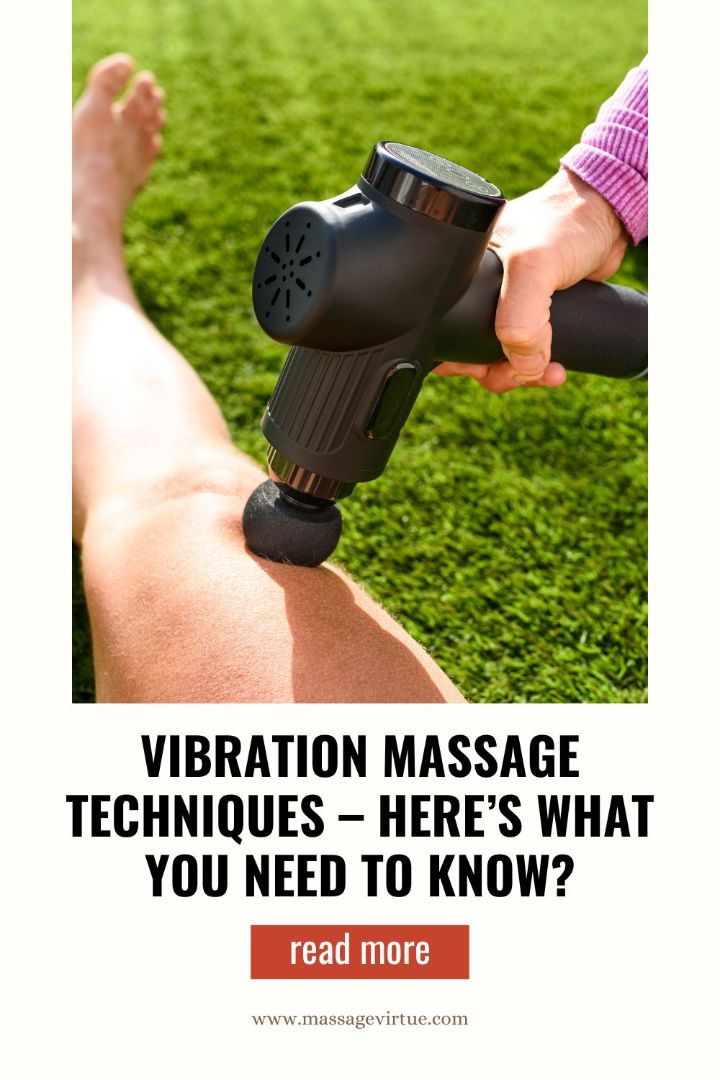If you’re looking for effective ways to relax, relieve stress, ease muscle tension, or enhance your flexibility, vibration massage techniques could be the answer you’ve been searching for.
Whether you’re new to the world of massage or a seasoned enthusiast, this comprehensive guide will provide you with insights, benefits, and practical tips on incorporating vibration massage into your wellness routine.
Let’s dive straight into the world of vibration massage techniques.
What is a Vibration Massage?
Vibration massage is a therapeutic practice that involves the use of mechanical vibrations to apply pressure to the body’s muscles and tissues.

These gentle oscillations can be delivered through various devices, such as massage guns or vibrating platforms.
Vibration massage have gained popularity due to its ability to offer several health benefits.
Vibration Massage Techniques
Let’s delve into the core of this guide: the various vibration massage techniques. These methods help in achieving specific results and can be tailored to suit your preferences and needs.
Here are some key vibration massage techniques:
1. Whole-Body Vibration (WBV)
This technique entails positioning yourself on a vibrating platform, where gentle vibrations ripple through your entire body.
WBV provides an all-encompassing massage experience, aiding in relaxation, improved circulation, and muscle tension relief.
2. Localized Vibration
In this method, a handheld massage gun or similar device is employed to target specific muscle groups or areas of tension.
By directly applying the device to the problem area, localized vibration effectively eases tight muscles and encourages pain relief.
3. Percussive Vibration
Percussive vibration replicates the rhythmic tapping and pounding of traditional massage while incorporating the therapeutic element of vibration.
This technique excels at loosening muscle knots, enhancing blood flow, and promoting overall relaxation.
4. Oscillatory Vibration
Oscillatory vibrations introduce gentle rocking movements to relax the body.

Often administered through a massage table or chair, this method is ideal for unwinding, reducing stress, and improving flexibility.
5. Lineal Vibration
Lineal vibration imparts straight-line oscillations that penetrate deep into muscles, providing thorough stimulation.
It proves highly effective for athletes seeking muscle recovery and individuals desiring increased flexibility and range of motion.
Benefits of Vibration Massage
Now, let’s take a closer look at the remarkable benefits of vibration massage:
- Relaxation: Vibration massage promotes relaxation by reducing stress and tension. It can help you unwind after a long day or prepare your body and mind for a restful night’s sleep.
- Pain Relief: For those experiencing chronic pain or muscle soreness, vibration massage can offer relief. It helps in releasing trigger points and reducing discomfort.
- Muscle Tension: Vibration massage is especially effective at reducing muscle tension and tightness. It can improve your range of motion and flexibility.
- Post-Workout Recovery: Athletes often turn to vibration massage to aid in post-workout recovery. It can reduce muscle fatigue and expedite the healing process.
- Stimulates Blood Circulation: The gentle vibrations stimulate blood flow, enhancing oxygen delivery to your muscles and tissues, which aids in recovery and overall well-being.
Vibration Massage Side Effects
Vibration massage is generally safe and well-tolerated. However, like any therapy, there are some potential side effects. Here’s a quick overview in tabular form:
| Side Effect | Description |
| Muscle Soreness | Mild soreness after a vigorous session is possible. |
| Skin Irritation | Prolonged or intense vibration can cause skin irritation. |
| Nausea and Dizziness | Excessive vibration may induce nausea or dizziness. |
| Not Suitable for Everyone | People with certain medical conditions should avoid vibration massage. |
Tips for Vibration Massage
To make the most of your vibration massage experience, consider these tips:
1. Start Slowly: If you’re new to vibration massage, begin with shorter sessions and lower intensity settings to allow your body to adapt.
2. Stay Hydrated: Proper hydration is essential to support muscle recovery and prevent potential side effects.
3. Focus on Technique: Ensure you’re using the correct technique for your specific goals. Consult a professional if needed.
4. Listen to Your Body: If you experience discomfort or pain during the massage, stop immediately.
5. Maintenance: Regularly clean and maintain your massage device to ensure its longevity and effectiveness.
Conclusion
In conclusion, vibration massage techniques are a valuable addition to your wellness routine.
Whether you’re seeking relaxation, pain relief, or improved flexibility, these methods can provide you with the relief you need.
Remember to use these techniques responsibly and tailor them to your specific needs for the best results.
FAQs
Is It Safe to Do a Vibrating Massage?
Yes, vibrating massages are generally safe for most people.
However, it’s essential to use the right equipment and follow the instructions carefully.
If you have any medical conditions or concerns, it’s a good idea to consult with a healthcare professional before starting a vibrating massage routine.
What Is Vibration in Swedish Massage?
In Swedish massage, vibration is one of the techniques used by therapists. It involves the therapist using their hands or fingers to create a fast, rhythmic shaking or trembling motion.
This technique helps to relax muscles, improve circulation, and enhance the overall massage experience.
What Is a Vibrating Motion Massage Called?
A vibrating motion massage is often referred to as “percussion massage” or “vibration therapy.”
It’s a technique that uses rapid, repetitive movements to target muscles and provide various benefits, including relaxation, pain relief, and muscle recovery.


